Apple A1084 Apple Airport Express Base Station User Manual LL2513 Q61SU
Apple Inc. Apple Airport Express Base Station LL2513 Q61SU
Apple >
User Manual

AirPort Express
Setup Guide
LL2513_Q61SU.book Page 1 Thursday, May 20, 2004 5:44 PM

LL2513_Q61SU.book Page 2 Thursday, May 20, 2004 5:44 PM

3
Contents
4
Getting Started
9
Plugging In AirPort Express
11
Using AirPort Express
12
Using AirPort Express With Your Broadband Internet Service
14
Using AirPort Express With AirTunes to Play iTunes Music on Your Stereo
20
Using AirPort Express to Share a USB Printer
22
Extending the Range of an Existing AirPort Extreme or AirPort Express Network
25
Using the AirPort Express Assistant
31
Setting Advanced Options
32
AirPort Express on the Road
34
Tips and Troubleshooting
42
Learning More, Service, and Support
44
AirPort Express Specifications
LL2513_Q61SU.book Page 3 Thursday, May 20, 2004 5:44 PM

4
1
Getting Started
Congratulations on purchasing AirPort Express. Read
this guide to get started using it.
You can use AirPort Express to share your broadband Internet access with wireless
computers on your network, play iTunes music on your home stereo, and much more.
Your AirPort Express comes with AirTunes, a way play iTunes music through remote
speakers.
With AirPort Express, you can:
•
Create a wireless network in your home, then connect to the Internet and share the
connection with up to ten computers simultaneously. An entire family can be
connected to the Internet at the same time.
•
Connect AirPort Express to your home stereo or powered speakers and use AirTunes
to play your iTunes music on your home stereo from a Macintosh with an AirPort or
AirPort Extreme Card, or a compatible Windows XP or 2000 wireless computer.
LL2513_Q61SU.book Page 4 Thursday, May 20, 2004 5:44 PM

Getting Started
5
•
Set up a wireless connection to your Ethernet network. AirPort and AirPort Extreme-
equipped Macintosh computers or Windows XP or 2000 computers can then have
access to an entire network without being connected with a cable.
•
Extend the range of your network by adding AirPort Express to your existing AirPort
Extreme or AirPort Express wireless network (this is called a Wireless Distribution
System, or WDS).
•
Connect a USB printer to your AirPort Express. All of the computers on the AirPort
network, both wireless and wired, can print to it.
•
Create custom profiles so you can store settings for up to five different locations.
LL2513_Q61SU.book Page 5 Thursday, May 20, 2004 5:44 PM

6
Getting Started
About AirPort Express
AirPort Express has three ports, located on the bottom side:
•
Ethernet port (
G
) for connecting a DSL or cable modem, or for connecting to an
existing Ethernet network
•
Analog and optical digital audio stereo mini-jack (
-
) for connecting AirPort Express
to a home stereo or powered speakers
•
USB port ( ) for connecting a compatible printer to AirPort Express
Next to the ports is a reset button, which is used for troubleshooting your AirPort
Express. The status light on the side of AirPort Express shows the current status.
Status light
Reset button
Line Out port
(Analog and optical
digital audio mini-jack)
Ethernet port
USB port
AC plug adapter
LL2513_Q61SU.book Page 6 Thursday, May 20, 2004 5:44 PM
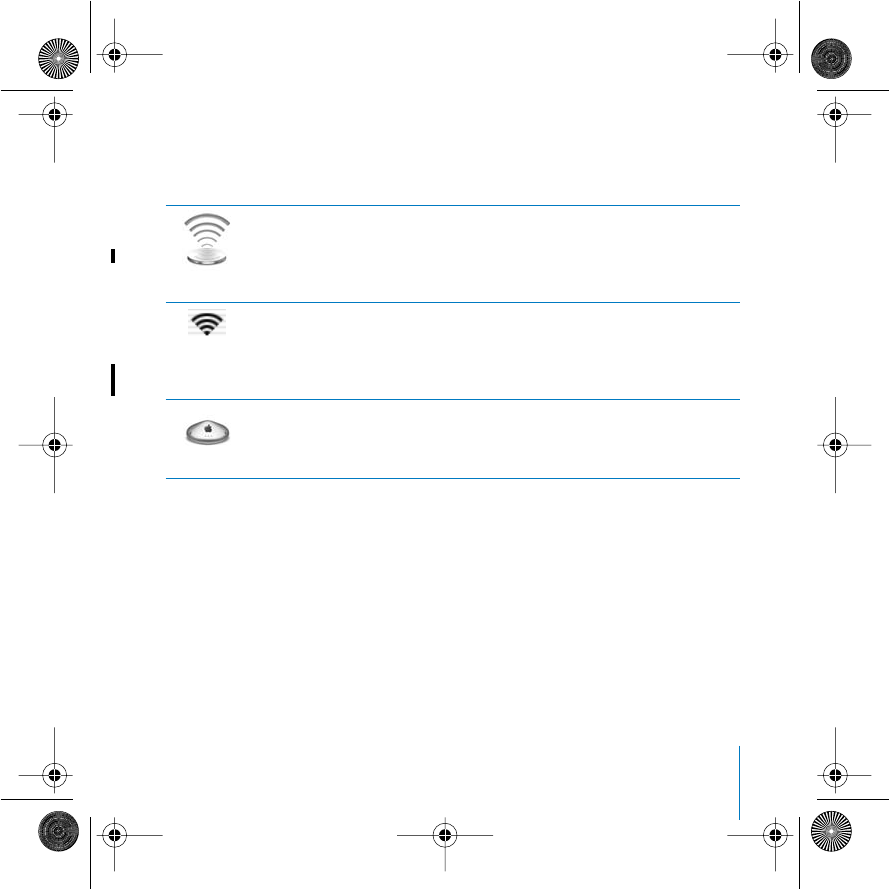
Getting Started
7
About the AirPort Software
AirPort Express works with the AirPort software included on the AirPort Express CD.
AirPort Express Assistant
Use the AirPort Express Assistant to set up your AirPort Express to connect to the
Internet, play iTunes music on your home stereo or powered speakers, and share a
printer. You can also bridge your AirPort Express to your existing AirPort Extreme or
AirPort Express wireless network to extend the range of your network (WDS).
AirPort status menu in the menu bar
Use the AirPort status menu to switch quickly between AirPort networks, monitor
the signal quality of the current network, create a Computer-to-Computer network,
and turn AirPort on and off. The status menu is available on computers using
Mac OS X.
AirPort Admin Utility
AirPort Admin Utility is an advanced tool for setting up and managing AirPort
Extreme and AirPort Express base stations. Use AirPort Admin Utility to adjust
network, routing, and security settings and other advanced options.
LL2513_Q61SU.book Page 7 Thursday, May 20, 2004 5:44 PM

8
Getting Started
What You Need to Get Started
To set up AirPort Express using a Macintosh, you must have the following:
•
A Macintosh computer with an AirPort or AirPort Extreme Card installed
•
Mac OS X v10.3 or later
•
iTunes 4.6 (included on the AirPort Express CD) or later
To set up AirPort Express using a Windows PC, you must have the following:
•
A Windows PC with 300 MHz or higher processor speed
•
Windows XP Home or Professional
•
iTunes 4.6 for Windows (included on the AirPort Express CD) or later
You need iTunes 4.6 or later to play audio from your computer to a stereo connected
to AirPort Express. To be sure you have the latest version of iTunes, go to
www.apple.com/itunes.
You can use AirPort Express with any wireless-enabled computer that is compliant with
the IEEE 802.11b or 802.11g standards. To set up AirPort Express, your computer must
meet the requirements listed above.
Note:
If you are using Windows 2000, use AirPort Admin Utility for Windows to
set up your AirPort Express. The AirPort Express Assistant is not compatible with
Windows 2000.
LL2513_Q61SU.book Page 8 Thursday, May 20, 2004 5:44 PM
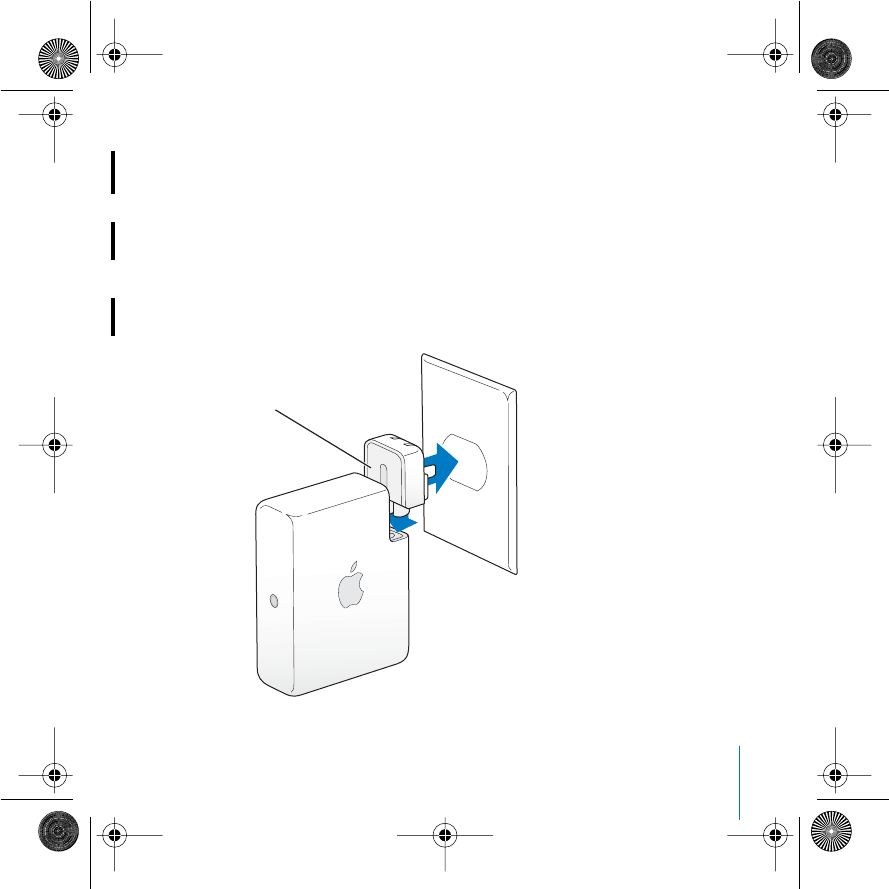
Getting Started
9
Plugging In AirPort Express
Before you plug in your AirPort Express, first connect the appropriate cables to the
ports you want to use, including the Ethernet cable connected to your DSL or cable
modem (if you will connect to the Internet), the audio cable connected to your stereo
(if you will use AirTunes to play music from iTunes) and a USB cable connected to a
compatible USB printer (if you will print to a USB printer).
Once you have connected the cables for all the devices you plan to use, connect the
AC plug adapter if necessary. Plug AirPort Express into the wall. There is no on switch.
AC plug adapter
LL2513_Q61SU.book Page 9 Thursday, May 20, 2004 5:44 PM
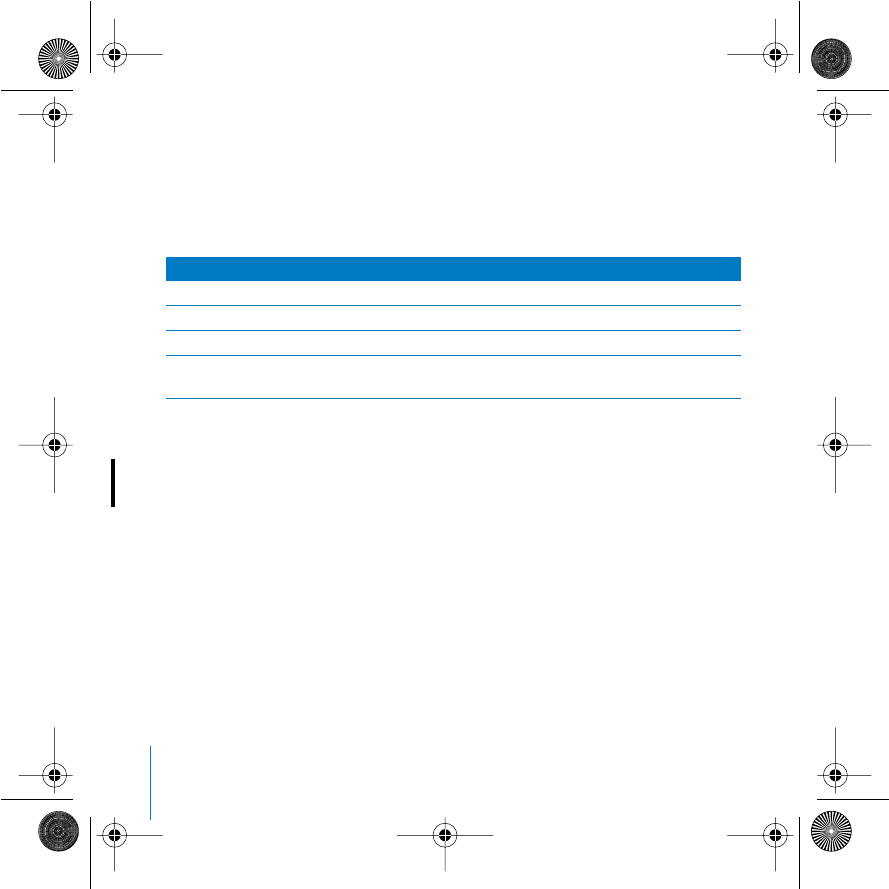
10
Getting Started
When you plug AirPort Express into the wall, the status light flashes green while it
starts up. Once it has started up completely, the status light glows solid green.
AirPort Express Status Lights
The following table explains AirPort Express light sequences and what they indicate.
What’s Next
After you plug in AirPort Express, you use the AirPort Express Assistant to set it up to
work with your Internet connection, stereo, USB printer, or existing network.
See “Using AirPort Express” on page 11 for examples of all the ways you can use AirPort
Express, and information about how to set them up.
Then see “Using the AirPort Express Assistant” on page 25 to find out more about the
setup process.
Light Status/description
Off
AirPort Express is unplugged.
Flashing green
AirPort Express is starting up.
Solid green
AirPort Express is on and working properly.
Flashing yellow
AirPort Express may be out of range, or there may be a problem
with your Internet service provider.
LL2513_Q61SU.book Page 10 Thursday, May 20, 2004 5:44 PM

11
1
Using AirPort Express
In this chapter you’ll find explanations of the
different ways you can use AirPort Express.
This chapter gives examples of how your setup might look, depending on how you
use AirPort Express. It also gives a brief explanation of what you need to do to
get your AirPort Express network up and running quickly.
LL2513_Q61SU.book Page 11 Thursday, May 20, 2004 5:44 PM
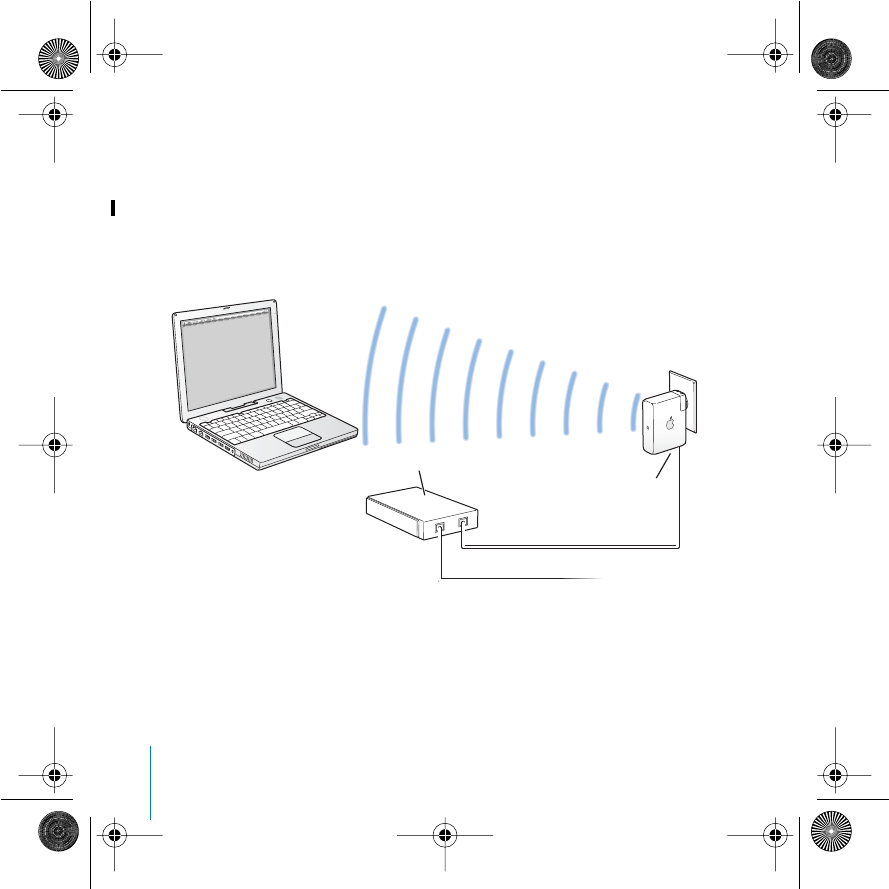
12
Using AirPort Express
Using AirPort Express With Your Broadband Internet Service
When you set up AirPort Express to provide network and Internet access, Macintosh
computers with AirPort and AirPort Extreme Cards and 802.11b and 802.11g wireless-
equipped computers can access the wireless AirPort network to share files, play games,
and use Internet applications like web browsers and email applications.
What It Looks Like
DSL or cable modem
Ethernet port
to Internet
G
LL2513_Q61SU.book Page 12 Thursday, May 20, 2004 5:44 PM

Using AirPort Express
13
How to Set It Up
1
Connect your DSL or cable modem to your AirPort Express using the
Ethernet port (
G
).
2
Use the AirPort Express Assistant to create a new network. (See page 25 for
more information.)
During the setup process, the AirPort Express Assistant looks on your computer for
your current Internet settings, and asks you to confirm them and add any additional
information you may have received from your service provider.
Computers using AirPort and computers using other wireless cards or adapters connect
to the Internet through AirPort Express.
Wireless computers communicate with one another through AirPort Express.
LL2513_Q61SU.book Page 13 Thursday, May 20, 2004 5:44 PM

14
Using AirPort Express
Using AirPort Express With AirTunes to Play iTunes Music
on Your Stereo
You can connect your AirPort Express to your stereo with a Toslink-to-mini digital fiber
optic cable or a mini-stereo-to-dual-RCA cable, and use AirTunes to wirelessly play
music from iTunes.
What It Looks Like
Optical digital audio input port
or
or
Toslink digital
fiber optic cable
or
Mini stereo to
dual RCA cable
Stereo receiver
Computer with iTunes
Line Out
port
RCA-type left
and right audio
input ports
LL2513_Q61SU.book Page 14 Thursday, May 20, 2004 5:44 PM

Using AirPort Express
15
How to Set It Up
1
Connect your AirPort Express to your home stereo or powered speakers using a digital
fiber optic cable or analog mini-stereo-to-dual-RCA connected to the stereo mini-jack
(
-
).
2
Use the AirPort Express Assistant to create a new network. (See page 25 for
more information.)
3
Open iTunes on your computer and choose your stereo or speakers from the speakers
pop-up menu in the lower right of the iTunes window.
Wireless computers within range of AirPort Express can wirelessly stream music to it
using iTunes 4.6 or later. Only one computer at a time can stream music to AirPort
Express.
LL2513_Q61SU.book Page 15 Thursday, May 20, 2004 5:44 PM
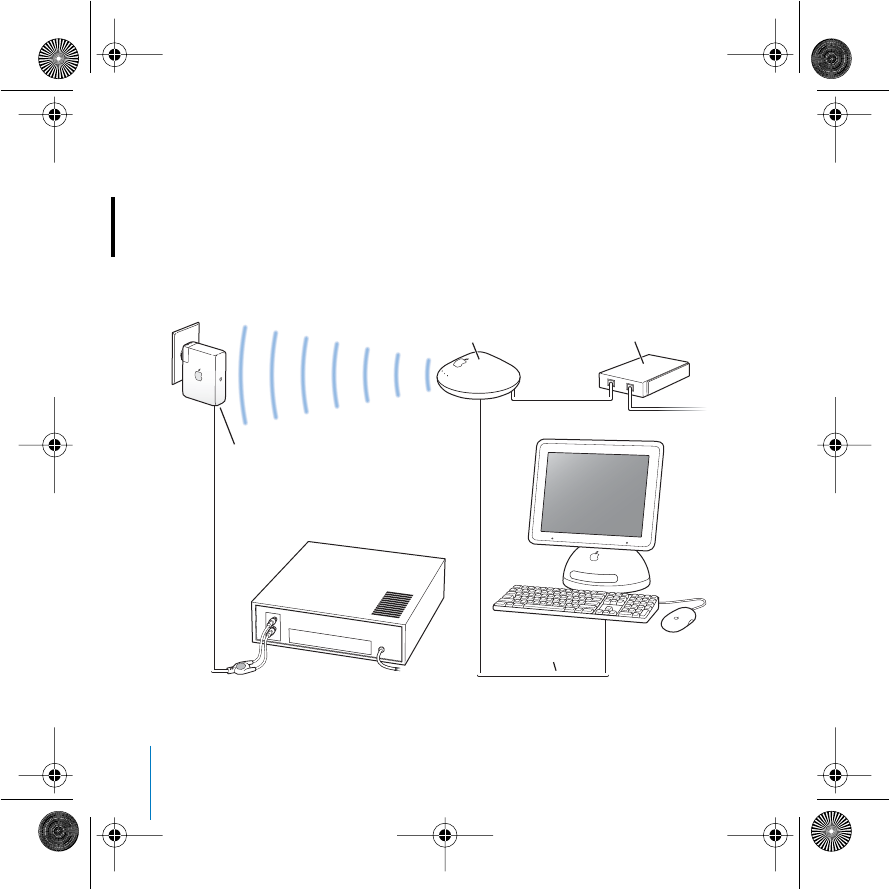
16
Using AirPort Express
Using AirPort Express on an Existing Wireless Network to Stream
Music to Your Home Stereo
You can also connect AirPort Express to a wireless network and use AirTunes to play
music on your stereo from iTunes. Connecting AirPort Express to your existing network
allows you to place AirPort Express in another room, within range of your network.
What It Looks Like
Use the AirPort Express Assistant to join your existing wireless network.
DSL or cable
modem
to Internet
Stereo receiver
Line Out port
AirPort Extreme
Base Station
to Ethernet
port
LL2513_Q61SU.book Page 16 Thursday, May 20, 2004 5:44 PM
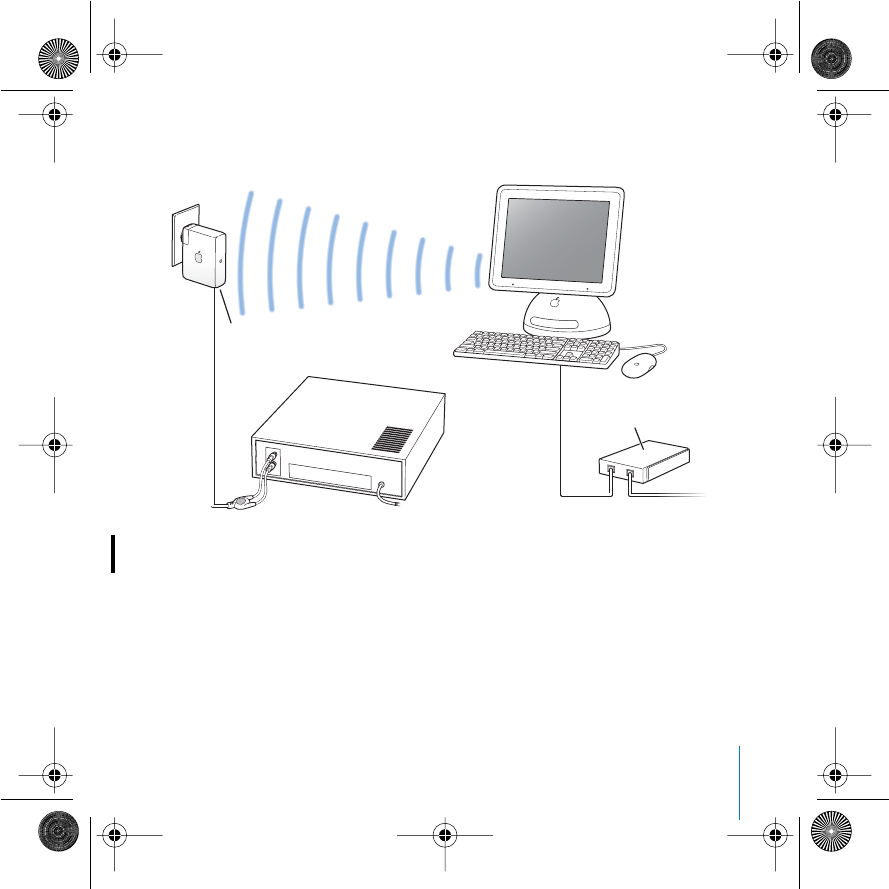
Using AirPort Express
17
There are also other ways you can connect your AirPort Express to your home stereo.
If your computer has an AirPort or AirPort Extreme Card installed, your can use AirTunes
to play iTunes music on a stereo connected to your AirPort Express.
DSL or cable
modem
to Internet
Stereo receiver
Line Out port
LL2513_Q61SU.book Page 17 Thursday, May 20, 2004 5:44 PM
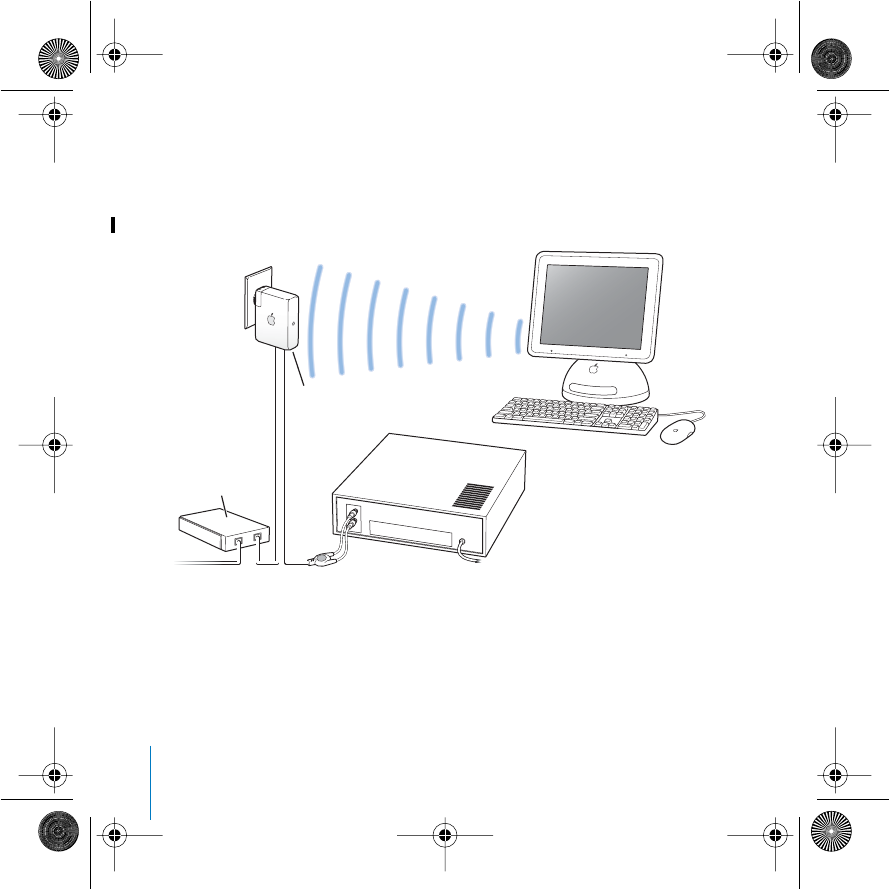
18
Using AirPort Express
You can also connect your AirPort Express to the Internet and provide Internet access
to computers that join the network. Connect your AirPort Express to your home stereo
and computers on the network with AirPort Extreme Cards or computers with
compatible 802.11g cards can use iTunes to play music on the stereo.
DSL or cable
modem
to Internet
Stereo
receiver
Line Out port
LL2513_Q61SU.book Page 18 Thursday, May 20, 2004 5:44 PM
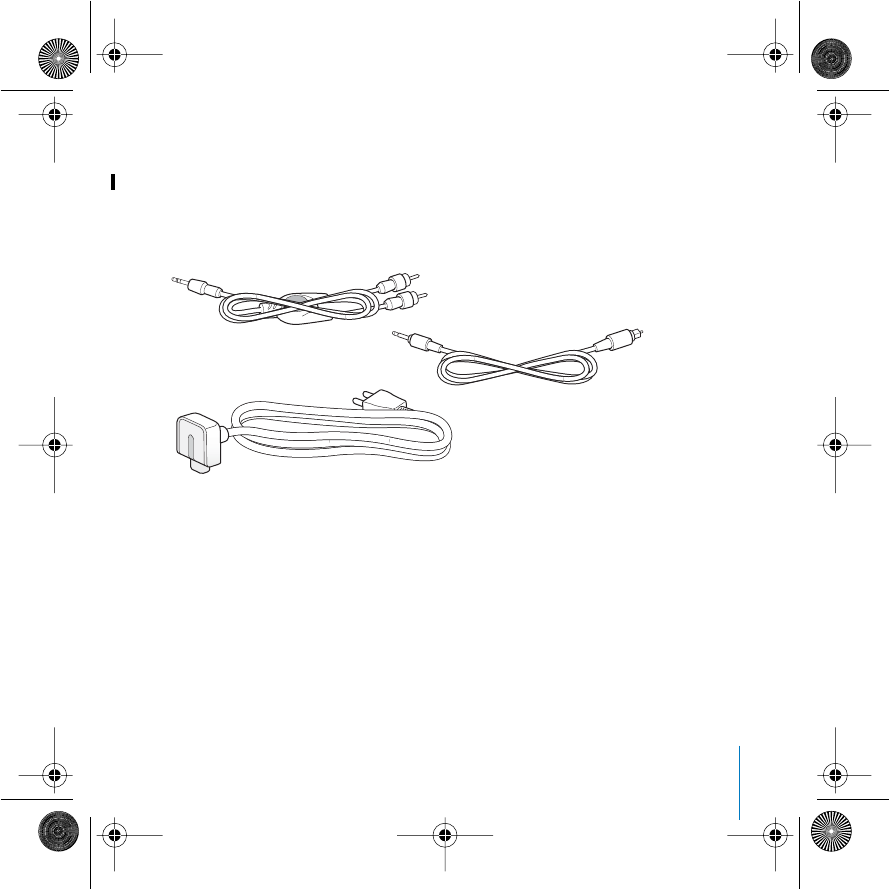
Using AirPort Express
19
Optional Audio Cable and Power Cord
You can purchase the optional AirPort Express Stereo Connection Kit with Monster
Cables to connect your AirPort Express to your home stereo or powered speakers. The
kit includes analog mini-stereo-to-dual-RCA connectors, a Toslink digital fiber optic
cable, and a power cord.
•
Connect the analog cable to your home stereo if it uses standard analog cables.
•
Connect the digital fiber optic cable if your stereo has a digital Toslink port.
•
Connect the power cord if you are setting up your AirPort Express away from a
power outlet.
Mini stereo to
dual RCA cable
Toslink digital
fiber optic cable
Power cord
LL2513_Q61SU.book Page 19 Thursday, May 20, 2004 5:44 PM
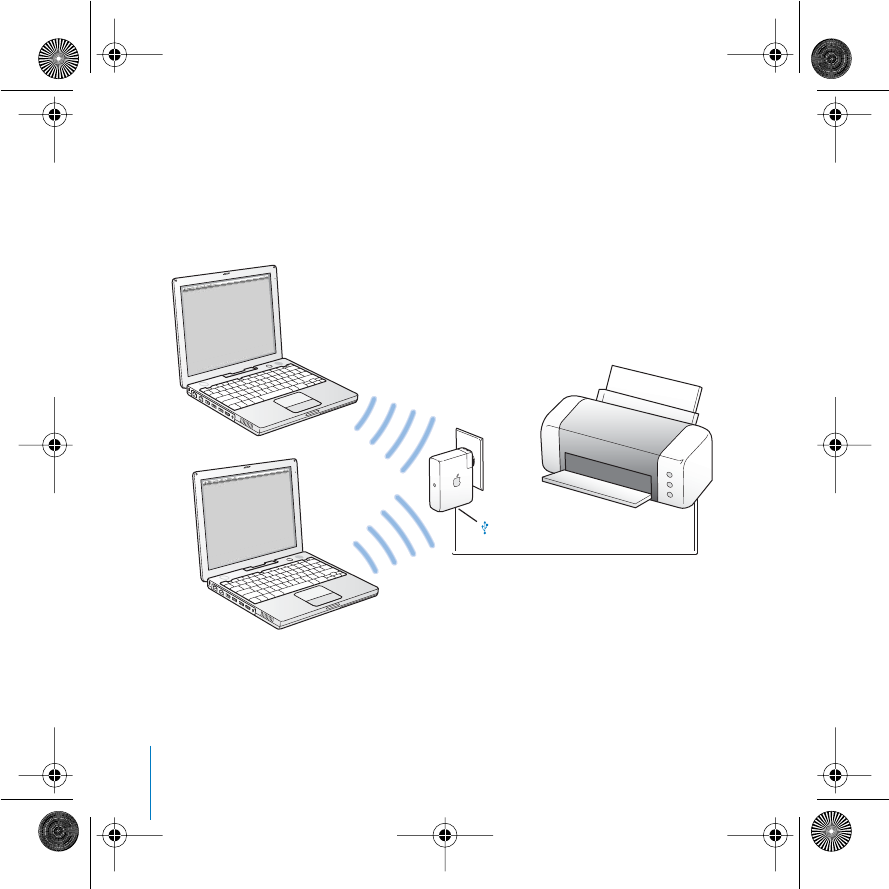
20
Using AirPort Express
Using AirPort Express to Share a USB Printer
When you connect a USB printer to your AirPort Express, all of the computers on the
wireless network can print to it.
What It Looks Like
USB port
Shared printer
LL2513_Q61SU.book Page 20 Thursday, May 20, 2004 5:44 PM

Using AirPort Express
21
How to Set It Up
1
Connect the printer to the AirPort Express USB port ( ) using a USB cable.
2
Use the AirPort Express Assistant to create a new network or, if you have an
existing wireless network, join the network. (See page 25 for more information.)
Wireless computers can print to the printer using Mac OS X v10.3 or later, or
Windows 2000 or Windows XP.
To use the printer from a computer using Mac OS X:
1
Open Printer Setup Utility (located in Applications/Utilities).
2
Select the printer from the list.
If the printer is not in the list, click Add and choose Rendezvous from the pop-up
menu, then select the printer from the list.
To use the printer from a computer using Windows:
1
Open “Printers and Faxes” from the Start menu.
2
Click Add Printer and then follow the onscreen instructions.
3
Select “Local printer attached to this computer” and deselect “Automatically detect
and install my Plug and Play printer.”
4
In the “Select the Printer Port” screen, click “Create a new port” and choose Standard
TCP/IP Port from the pop-up menu.
5
Click Next and follow the onscreen instructions.
6
In “Printer Name or IP Address,” enter 10.0.1.1. “IP_10.0.1.1 ” i s generated as the port name.
Note:
If you gave your AirPort Express a different IP address, use it instead of 10.0.1.1.
The port will be named with the address you enter.
7
Select Standard for Device Type and select your printer in the list.
LL2513_Q61SU.book Page 21 Thursday, May 20, 2004 5:44 PM
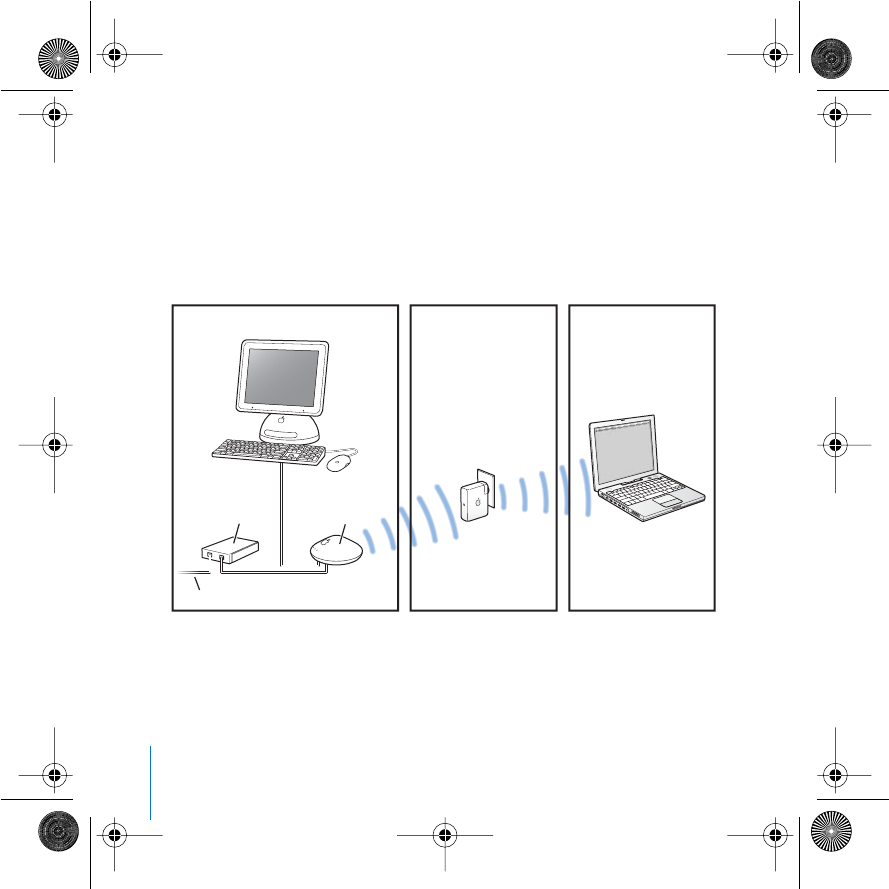
22
Using AirPort Express
Extending the Range of an Existing AirPort Extreme or
AirPort Express Network
You can connect an additional AirPort Express to extend the range of your existing
AirPort Extreme or AirPort Express network. Adding a base station or AirPort Express to
an existing network creates what is known as a Wireless Distribution System (WDS).
What It Looks Like
Family Room Dining Room Living Room
to Internet
AirPort Extreme
Base Station
DSL or cable
modem
LL2513_Q61SU.book Page 22 Thursday, May 20, 2004 5:44 PM

Using AirPort Express
23
How to Set It Up
1
You need to have an existing AirPort Extreme or AirPort Express network created by an
AirPort Extreme Base Station or an AirPort Express connected to the Internet. This base
station is called the
main base station
and shares its Internet connection with your
AirPort Express.
2
Use the AirPort Express Assistant to join the network, and then extend the network to
the AirPort Express. (See page 25 for more information.)
Both base stations share the Internet connection with client computers wirelessly, or
using Ethernet if the client computers are connected by Ethernet.
Note:
If your network is protected by either a WPA Personal or WPA Enterprise
password, you can’t set up a Wireless DIstribution System. If you want to set up a WDS,
you must choose either the 128-bit WEP or Not Enabled security option.
LL2513_Q61SU.book Page 23 Thursday, May 20, 2004 5:44 PM
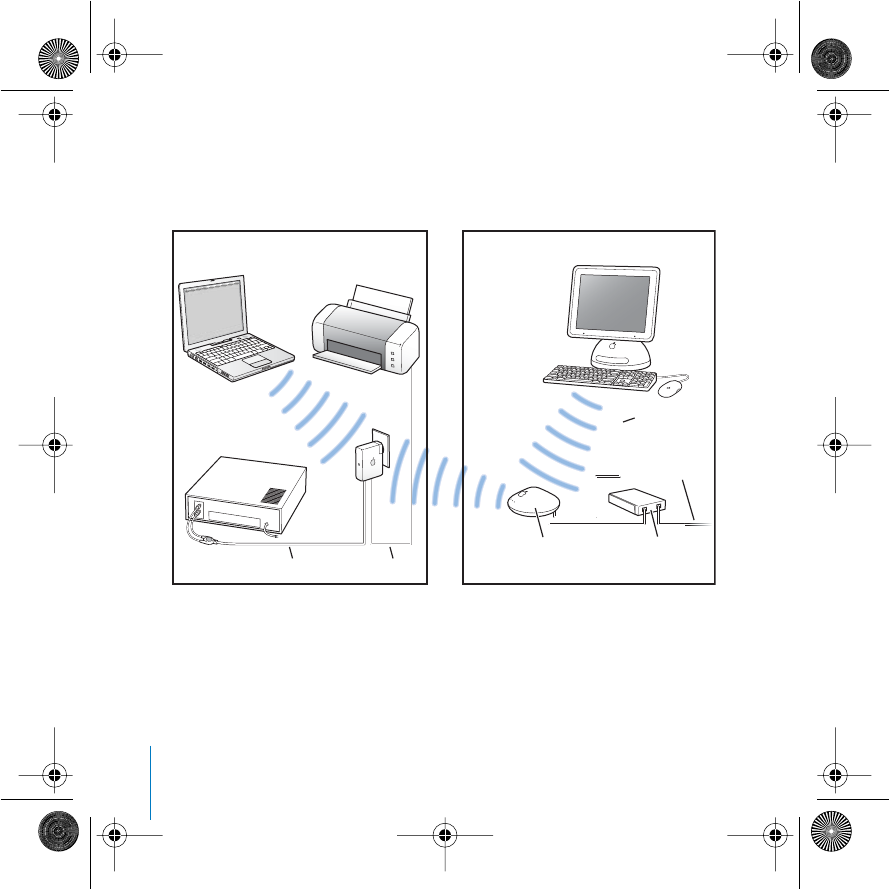
24
Using AirPort Express
Using AirPort Express With Your AirPort Extreme Network
The illustration below shows a wireless network with all of the above examples in a
single wireless network.
How to Set It Up
•
Use the AirPort Express Assistant to create a new network or join an existing network
and take advantages of all of the AirPort Express features.
DSL or cable
modem
to Line Out port to USB port
to Internet
to Ethernet
port
Family Room Living Room
AirPort Extreme
Base Station
LL2513_Q61SU.book Page 24 Thursday, May 20, 2004 5:44 PM

25
1
Using the AirPort Express
Assistant
This chapter provides information and instructions
for using the AirPort Express Assistant to set up your
AirPort Express.
Use the diagrams in the previous chapter to help you decide where you want to use
your AirPort Express, and what features you want to set up on your AirPort network.
Then use the instructions in this chapter to easily configure AirPort Express and set up
your network.
AirPort Express lets you:
•
Set up a new network that wireless computers can use to communicate with each
other. If you set up your AirPort Express as a base station and connect it to the
Internet, wireless computers can also share the Internet connection.
•
Connect your AirPort Express to your existing wireless network.
•
Connect your AirPort Express to your existing AirPort Extreme or AirPort Express
network and extend the range of your wireless network using the AirPort Express as a
wireless bridge. This is known a WDS (Wireless Distribution System).
You can use AirTunes to play music from iTunes and share a USB printer in any type of
network you set up, whether it is a new network or an existing network.
LL2513_Q61SU.book Page 25 Thursday, May 20, 2004 5:44 PM

26
Using the AirPort Express Assistant
If you have more than one AirPort Express, you can connect one to the stereo in your
living room and connect another to the powered speakers in your den. Using AirTunes,
you can stream your iTunes music to either AirPort Express, depending on where you
are in your house. Choose the name of the AirPort Express you want to use from the
speakers pop-up menu in iTunes.
This chapter provides an overview for using the AirPort Express Assistant to set up your
network and other features of your AirPort Express. For more detailed wireless
networking information, and for information about the advanced features of AirPort,
refer to the document “Designing AirPort Networks,” or “AirPort Networks for Windows,”
located on the AirPort Express CD, and at www.apple.com/airport.
You can do most of your network setup and configuration tasks with the AirPort
Express Assistant. To set advanced options, you need to use AirPort Admin Utility.
See “Setting Advanced Options” on page 31.
Note:
If you are using Windows 2000, use AirPort Admin Utility for Windows to
set up your AirPort Express. The AirPort Express Assistant is not compatible with
Windows 2000.
Using the AirPort Express Assistant
To set up and configure your AirPort Express to use AirPort for wireless networking
and Internet access, use the AirPort Express Assistant. (The assistant is installed on your
computer when you install the software on the AirPort Express CD.)
On a Macintosh computer using Mac OS X v10.3 or later:
n
Open the AirPort Express Assistant, located in Applications/Utilities, and follow the
onscreen instructions.
LL2513_Q61SU.book Page 26 Thursday, May 20, 2004 5:44 PM
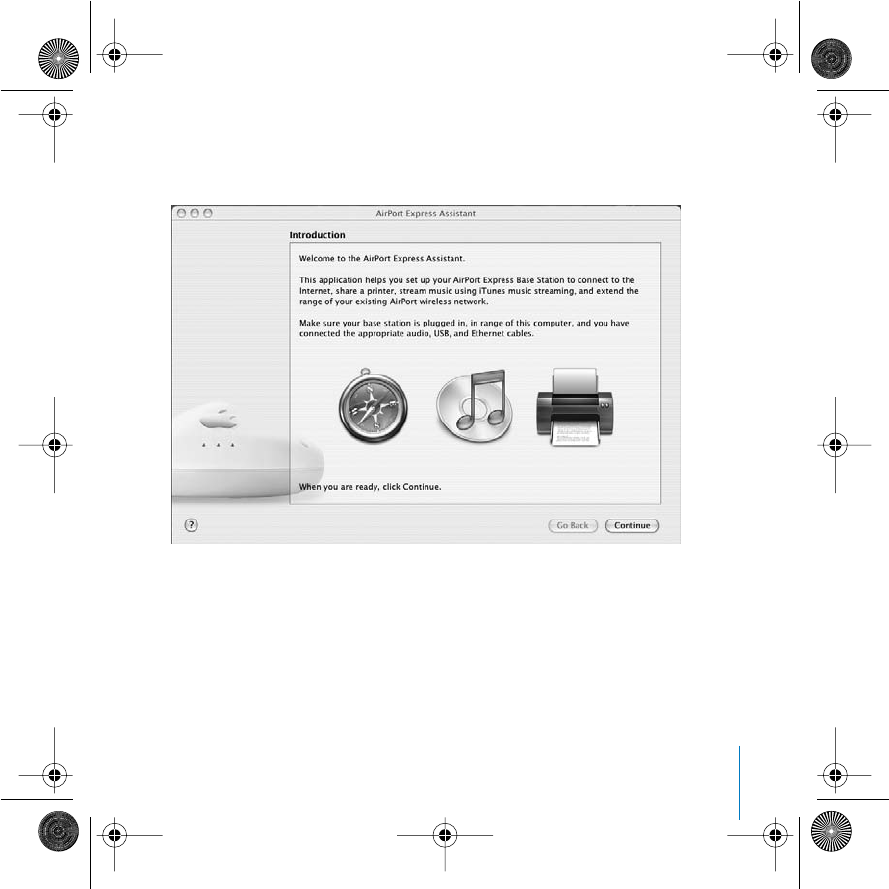
Using the AirPort Express Assistant
27
On a computer using Windows XP:
n
Open the AirPort Express Assistant, located in the Applications folder.
You will be asked a series of questions about the type of network you want to use and
the services you want to set up. The AirPort Express Assistant helps you enter the
appropriate settings for the network you are setting up.
LL2513_Q61SU.book Page 27 Thursday, May 20, 2004 5:44 PM

28
Using the AirPort Express Assistant
If you are using AirPort Express to connect to the Internet, you need a broadband (DSL
or cable modem) account with an Internet service provider. Fees may apply. If you
received specific information from your ISP (such as a static IP address or a DHCP client
ID), you may need to enter it in the AirPort Express Assistant. Have this information
available before you set up your AirPort Express.
Creating a New Wireless Network
You can use the AirPort Express Assistant to create a new wireless network. The AirPort
Express Assistant guides you through the steps necessary to name your network,
protect your network with a password, and set other options.
If you plan to use AirTunes to play music on your stereo from iTunes, connect a Toslink
digital fiber optic cable or a mini-stereo-to-dual-RCA cable to the AirPort Express Line
Out port (
-
) and to your stereo.
If you plan to share a USB printer on your network, connect the printer to the AirPort
Express USB port ( ).
After you connect the audio cable and the USB printer cable:
n
Open the AirPort Express Assistant, located in Applications/Utilities on a Macintosh,
and in the Applications folder on a computer using Windows XP. Follow the onscreen
instructions to create a new network.
LL2513_Q61SU.book Page 28 Thursday, May 20, 2004 5:44 PM

Using the AirPort Express Assistant
29
Configuring and Sharing Internet Access
If you plan to share your Internet connection with computers on your network, you
need to set up your AirPort Express as an AirPort base station. Once it is set up,
computers access the Internet via the AirPort network. The base station connects to the
Internet and transmits information to the computers over the AirPort network.
Before you use the AirPort Express Assistant to set up your base station, connect your
DSL or cable modem to the AirPort Express Ethernet port (G). If you are using an
existing Ethernet network with Internet access to connect to the Internet, you can
connect the AirPort Express to the Ethernet network instead. If you plan to use
AirTunes to play music on your stereo from iTunes, connect an audio cable to the
analog and optical digital audio mini-jack (-) and to your stereo.
Use the AirPort Express Assistant to provide AirPort Express with your ISP settings and
configure how the base station shares the settings with other computers.
nOpen the AirPort Express Assistant, located in Applications/Utilities on a Macintosh,
and in the Applications folder on a computer using Windows XP. Follow the onscreen
instructions to configure and share Internet access on your AirPort Express.
LL2513_Q61SU.book Page 29 Thursday, May 20, 2004 5:44 PM

30 Using the AirPort Express Assistant
Connecting to an Existing Wireless Network
You can use the AirPort Express Assistant to join an existing wireless network. When
you connect your AirPort Express to your home stereo, computers on your wireless
network can use AirTunes to play music on the stereo from iTunes. If you connect a
USB printer to your AirPort Express, all of the computers on the network can print to it.
Be sure to connect the audio cable to your stereo and the USB cable to your printer
before you use the AirPort Express Assistant.
nOpen the AirPort Express Assistant. Follow the onscreen instructions to connect your
AirPort Express to your wireless network.
Extending the Range of an Existing AirPort Extreme or AirPort
Express Network
You can use the AirPort Express Assistant to extend the range of an existing AirPort
Extreme or AirPort Express wireless network. Wireless computers can connect to the
network and share the Internet connection, share files, and play network games. If you
connect your AirPort Express to your home stereo, computers on your wireless network
can use AirTunes to play music on the stereo from iTunes. If you connect a USB printer
to your AirPort Express, all of the computers on the network can print to it.
nOpen the AirPort Express Assistant. Follow the onscreen instructions to extend the
range of your AirPort Express or AirPort Express network.
Note: Extending the range of an AirPort Extreme or AirPort Express network may
reduce overall network performance.
LL2513_Q61SU.book Page 30 Thursday, May 20, 2004 5:44 PM

Using the AirPort Express Assistant 31
Setting Advanced Options
To set advanced options, use AirPort Admin Utility.
You can use AirPort Admin Utility to configure advanced base station settings, such as
advanced security options, closed networks, DHCP lease time, access control, WAN
privacy, power controls, remote dial-in or port mapping, and more.
To set advanced options:
1Choose the wireless network you want to change from the AirPort status menu.
2Open AirPort Admin Utility, located in Applications/Utilities on a Macintosh, and in the
Applications folder on a computer using Windows XP or Windows 2000.
3If there is more than one base station in the list, select the base station you want to
configure. If you don’t see the base station you want to configure, click Rescan to scan
for available base stations, then select the base station.
4If you are prompted for a password, enter it, then click Configure.
For more information and instructions for using AirPort Admin Utility, see the
document “Designing AirPort Networks” or “AirPort Networks for Windows,” located on
your AirPort Express CD and at www.apple.com/airport.
LL2513_Q61SU.book Page 31 Thursday, May 20, 2004 5:44 PM

32 AirPort Express on the Road
1AirPort Express on the Road
AirPort Express can store settings for different
locations so you can easily move it from place
to place.
AirPort Express can store up to 5 different configurations, known as profiles. A profile
contains settings for your AirPort Express, such as the iTunes speaker name and
password, and network information, such as network name and password.
Profiles may be useful if you move your AirPort Express from one location to another.
For example, you might have one profile for your AirPort Express at home, where you
use AirTunes to play music on your home stereo from iTunes and connect to the
Internet using PPPoE. You might have another profile for using AirPort Express in a
hotel, where you connect to the Internet using DHCP.
Use AirPort Admin Utility, located in Applications/Utilities, to create, edit, rename, and
delete profiles.
LL2513_Q61SU.book Page 32 Thursday, May 20, 2004 5:44 PM
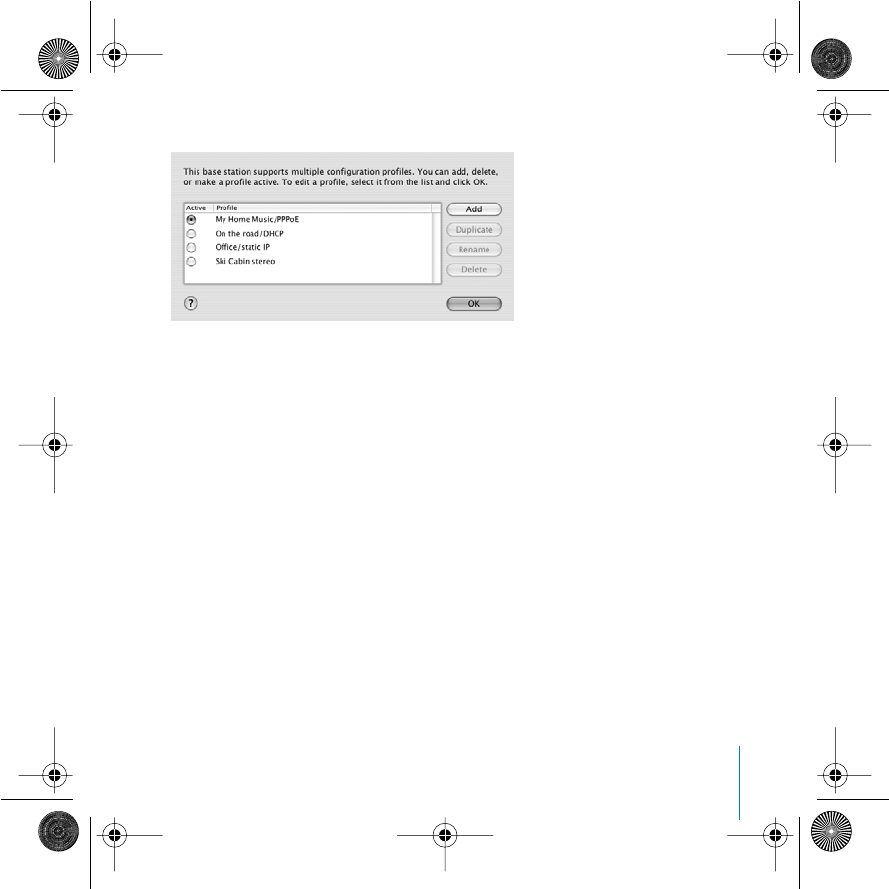
AirPort Express on the Road 33
To create a new profile:
1Open AirPort Admin Utility, located in Applications/Utilities.
2Select your AirPort Express in the list and click Configure.
3Click the Profiles icon in the toolbar.
4Click Add to create a new profile, give the profile a name, then click OK.
5Set options, such as network name, remote speaker name, passwords, and the
Internet connection method.
6When you are finished setting the options, click Update.
To edit an existing profile:
1Open AirPort Admin Utility, located in Applications/Utilities.
2Select your AirPort Express in the list and click Configure.
3Click the Profiles icon in the toolbar.
4Select a profile in the list and click OK.
5Edit options for the profile. When you are finished editing the options, click Update
to save the profile.
LL2513_Q61SU.book Page 33 Thursday, May 20, 2004 5:44 PM

34
1Tips and Troubleshooting
You can quickly solve most problems with AirPort
Express by following the advice in this chapter.
The AirPort Express Assistant Can’t Detect the Proper AirPort Hardware
Make sure that the computer you are using has an AirPort Card or an AirPort Extreme
Card installed. If you recently installed the card, shut down your computer and make
sure the card is properly installed. Make sure that the AirPort antenna is securely
connected to the card (you should hear a click when the antenna is connected
securely). Make sure that the other end of the card is firmly inserted into the connector
in the AirPort Card slot.
If you are using a computer with Windows 2000 or Windows XP, make sure the wireless
card or adapter is installed correctly. See the documentation that came with your
computer to check the connection.
LL2513_Q61SU.book Page 34 Thursday, May 20, 2004 5:44 PM

Tips and Troubleshooting 35
You Can’t Play Music on Your Stereo From iTunes
Make sure your AirPort Express is plugged in to a power outlet, is in range of your
computer, and that you have connected the appropriate cables. You may need to join
the AirPort Express network.
Make sure to choose your AirPort Express from the speakers pop-up menu in iTunes.
Make sure you are using iTunes 4.6 or later.
You Can't Hear Music Playing
If music is playing (the progress bar at the top of the iTunes window is moving) but
you can't hear anything, check the following:
•If you're trying to play music through speakers connected to an AirPort Express, and
you've selected the “Disable iTunes volume control for remote speakers” checkbox in
the Audio pane of iTunes Preferences, make sure your remote speakers are selected
in the pop-up menu at the bottom of the iTunes window and the volume control on
the remote speakers isn't turned down.
You Forgot Your Network or AirPort Express Password
You can clear the AirPort network or AirPort Express password by resetting AirPort
Express. Follow these steps:
1Use the end of a straightened paper clip to press and hold the reset button for one
second.
2Select your AirPort network.
•On a Macintosh, use the AirPort status menu in the menu bar to select the network
created by AirPort Express (the network name does not change).
LL2513_Q61SU.book Page 35 Thursday, May 20, 2004 5:44 PM
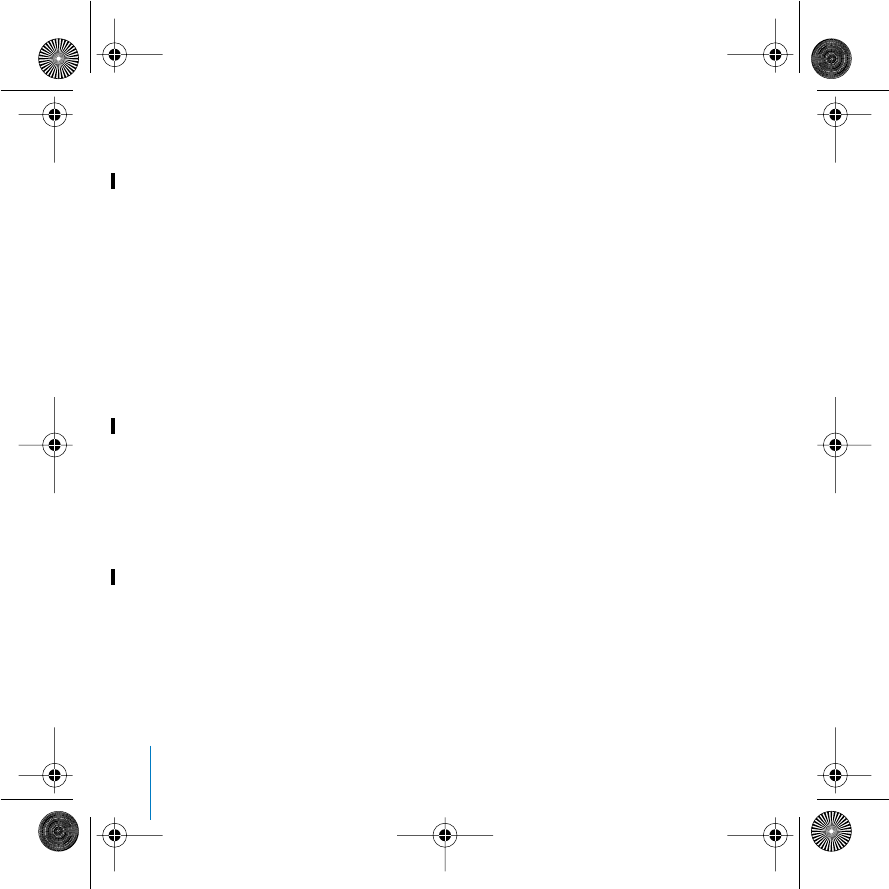
36 Tips and Troubleshooting
•On a computer using Windows 2000 or Windows XP, hold the pointer over the wireless
connection icon until you see your AirPort Network Name (SSID), and choose it from
the list if there are multiple networks available.
3Open AirPort Admin Utility (in Applications/Utilities).
4Select your AirPort Express and click Configure.
5In the dialog that appears, make the following changes:
•Reset the AirPort Express password.
•Turn encryption on to activate password protection for your AirPort network. If you
turn on encryption, enter a new password for your AirPort network.
6Click OK.
AirPort Express restarts to load the new settings.
Your AirPort Express Isn’t Responding
Try unplugging it and plugging it back in to a power outlet.
If your AirPort Express stops responding completely, you may need to reset it to the
factory default settings. This erases all of the settings you’ve made and resets them to
the settings that came with the AirPort Express.
To return AirPort Express to the factory settings:
nUse the end of a straightened paper clip to press and hold the reset button for five full
seconds.
AirPort Express restarts with the following settings:
•AirPort Express receives its IP address using DHCP.
•The network name reverts to Apple Network XXXXXX (where X is a letter or number).
•The AirPort Express password returns to public.
LL2513_Q61SU.book Page 36 Thursday, May 20, 2004 5:44 PM

Tips and Troubleshooting 37
If you used AirPort Admin Utility to create profiles for your AirPort Express, they are
preserved when you reset your AirPort Express.
If you need to return your AirPort Express to the factory settings and remove any
profiles you have set up:
1Unplug AirPort Express.
2Use the end of a straightened paper clip to hold the reset button while you plug in
AirPort Express.
Your Printer Isn’t Responding
If you connected a printer to the USB port on AirPort Express and the computers on
the AirPort network can’t print, try doing the following:
1Make sure the printer is plugged in and turned on.
2Make sure the cables are securely connected to the printer and to the AirPort Express
USB port.
3Make sure the printer is selected in the Printer List on client computers. To do this on a
Macintosh using Mac OS X v10.3 or later:
•Open Printer Setup Utility, located in Applications/Utilities.
•If the printer is not in the list, click Add.
•Choose Rendezvous from the pop-up menu.
•Select the printer and click Add.
To select your printer on a computer using Windows XP or Windows 2000:
•Open “Printers and Faxes” from the Start menu.
•Select the printer. If the printer is not in the list, click Add Printer and then follow the
onscreen instructions.
LL2513_Q61SU.book Page 37 Thursday, May 20, 2004 5:44 PM

38 Tips and Troubleshooting
For more information about setting up a printer on a computer using Windows, see “To
use the printer from a computer using Windows:” on page 21.
I Want to Update My AirPort Software
Apple periodically updates AirPort software to improve performance or add features. It
is recommended that you update your AirPort Express to use the latest software. To
download the latest version of AirPort Express software, go to
www.apple.com/airport.
AirPort Express Placement Considerations
The following recommendations can help your AirPort Express achieve maximum
wireless range and optimal network coverage.
•Place your AirPort Express in an open area where there are few obstructions,
such as large pieces of furniture or walls. Try to place it away from metallic surfaces.
•If you place your AirPort Express behind furniture, keep at least an inch of space
between the AirPort Express and the edge of the furniture.
•Avoid placing your AirPort Express in areas surrounded by metal surfaces on
three or more sides.
•If you place your AirPort Express in an entertainment center with your stereo
equipment, avoid completely surrounding AirPort Express with audio, video, or
power cables. Place your AirPort Express so the cables are to one side. Maintain as
much space as possible between AirPort Express and the cables.
•If you place your AirPort Express behind your stereo equipment, place it on one side
or the other. Avoid centering it behind your stereo.
•Try to place your AirPort Express at least 25 feet from a microwave oven and a 2.4
GHz cordless phone, or other sources of interference.
LL2513_Q61SU.book Page 38 Thursday, May 20, 2004 5:44 PM

Tips and Troubleshooting 39
Items That Can Cause Interference With AirPort
The farther away the interference source, the less likely it is to cause a problem. The
following items can cause interference with AirPort communication:
•Microwave ovens
•DSS (Direct Satellite Service) radio frequency leakage
•The original coaxial cable that came with certain types of satellite dishes. Contact
the device manufacturer and obtain newer cables.
•Certain electrical devices such as power lines, electrical railroad tracks, and power
stations
•Cordless telephones that operate in the 2.4 gigahertz (GHz) range. If you have
problems with your phone or AirPort communication, change the channel your base
station or AirPort Express uses.
•Adjacent base stations using nearby channels. For example, if base station A is set to
channel 1, base station B should be set to channel 4 or higher.
LL2513_Q61SU.book Page 39 Thursday, May 20, 2004 5:44 PM

LL2513_Q61SU.book Page 40 Thursday, May 20, 2004 5:44 PM

Tips and Troubleshooting 41
LL2513_Q61SU.book Page 41 Thursday, May 20, 2004 5:44 PM

42
1Learning More,
Service, and Support
You can find more information about using AirPort
Express on your hard disk, on the web, and in
onscreen help.
Online Resources
For the latest information on AirPort Express, go to www.apple.com/airport.
To register AirPort Express (if you didn’t do it when you installed the software on the
AirPort Express CD), go to www.apple.com/register.
For AirPort service and support information, a variety of forums with product-specific
information and feedback, and the latest Apple software downloads, go to
www.apple.com/support/airport.
For support outside of the United States, go to www.apple.com/support and choose
your country from the pop-up menu.
LL2513_Q61SU.book Page 42 Thursday, May 20, 2004 5:44 PM

Learning More, Service, and Support 43
Onscreen Help
nTo learn more about using AirPort, open AIrPort Admin Utility and choose
Help > AirPort Help.
Obtaining Warranty Service
If the product appears to be damaged or does not function properly, please follow
the advice in this booklet, the onscreen help, and the online resources.
If the unit still does not function, go to www.apple.com/support for instructions
on how to obtain warranty service.
Finding the Serial Number of Your AirPort Express
The serial number is printed on the back of your AirPort Express.
LL2513_Q61SU.book Page 43 Thursday, May 20, 2004 5:44 PM

44
1AirPort Express Specifications
AirPort Specifications
•Wireless Data Rate: Up to 54 megabits per second (Mbps)
•Range: Up to 150 feet (45 meters) in typical use (varies with environment)
•Frequency Band: 2.4 gigahertz (GHz)
•Radio Output Power: 15 dBm (nominal)
•Standards: Compliant with 802.11 HR Direct Sequence Spread Spectrum (DSSS)
11 Mbps standard, 802.11 DSSS 1 and 2 Mbps standard, and 802.11g specification
Interfaces
•RJ-45 Ethernet LAN connector for built-in 10/100Base-T (G)
•Universal Serial Bus (USB) printing ( )
•Analog/digital optical 3.5mm mini-jack
•AirPort Extreme
Environmental Specifications
•Operating Temperature: 32° F to 95° F (0° C to 35° C)
•Storage Temperature: –13° F to 140° F (–25° C to 60° C)
•Relative Humidity (Operational): 20% to 80% relative humidity
•Relative Humidity (Storage): 10% to 90% relative humidity, noncondensing
•Operating Altitude: 0 to 10,000 feet (0 to 3048 m)
•Maximum Storage Altitude: 15,000 feet (4572 m)
LL2513_Q61SU.book Page 44 Thursday, May 20, 2004 5:44 PM

AirPort Express Specifications 45
Size and Weight
•Height: 3.7 inches (94 mm)
•Width: 2.9 inches (75 mm)
•Thickness: 1.12 inches (28.5 mm)
•Weight: 6.63 ounces (188 grams)
Hardware Addresses
The AirPort Express has two hardware addresses printed on the back of the case:
•AirPort ID: The address used to identify AirPort Express on a wireless network.
•Ethernet ID: This also known as the MAC address. You may need to provide this
address to your ISP to connect AirPort Express to the Internet.
Using AirPort Express
•The only way to shut off power completely to your AirPort Express is to disconnect it
from the power source.
•When connecting or disconnecting your AirPort Express, always hold it by its sides.
Keep fingers away from the metal part of the plug.
•Your AirPort Express is a high-voltage component and should not be opened for any
reason, even when the AirPort Express is unplugged. If your AirPort Express needs
service, see “Learning More, Service, and Support” on page 42.
•Never force a connector into the ports. If the connector and port do not join with
reasonable ease, they probably don’t match. Make sure that the connector matches
the port and that you have positioned the connector correctly in relation to the port.
•If you are using the optional power cord, avoid dangling AirPort Express from the
power cord.
LL2513_Q61SU.book Page 45 Thursday, May 20, 2004 5:44 PM
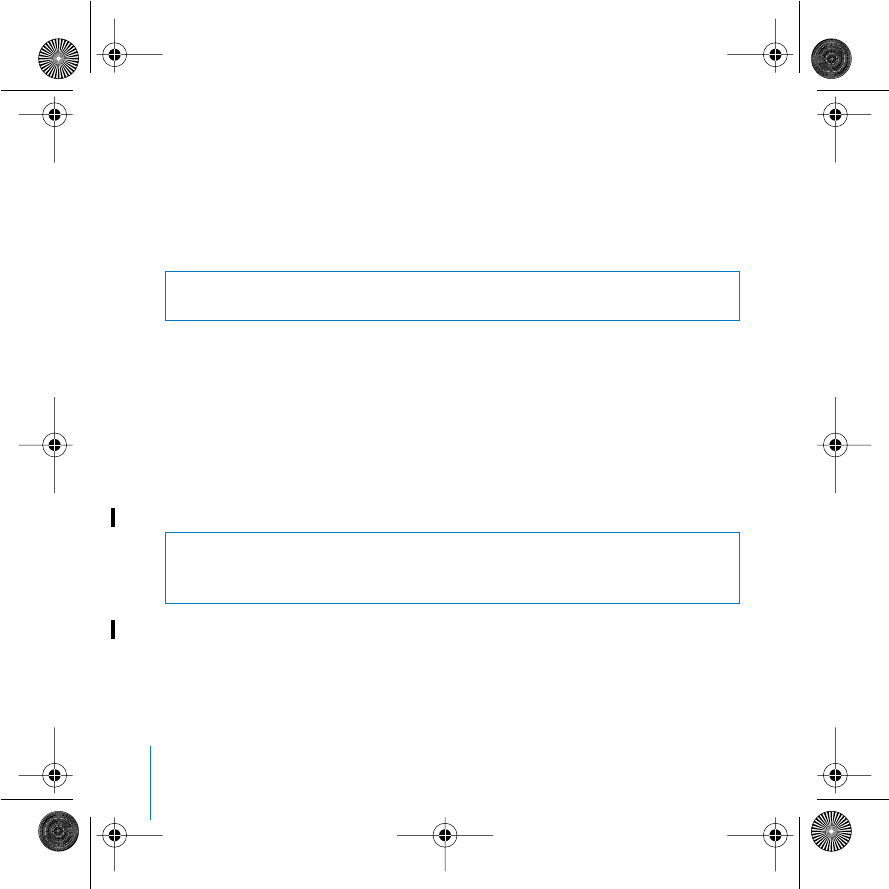
46 AirPort Express Specifications
About Operating and Storage Temperatures
•When you are using your AirPort Express, it is normal for the case to get warm. The
AirPort Express case functions as a cooling surface that transfers heat from inside the
unit to the cooler air outside.
Avoid Wet Locations
•Keep AirPort Express away from sources of liquids, such as drinks, washbasins,
bathtubs, shower stalls, and so on.
•Protect AirPort Express from direct sunlight and rain or other moisture.
•Take care not to spill any food or liquid on your AirPort Express. If you do, unplug
AirPort Express before cleaning up the spill.
In case of a spill, you may have to send your equipment to Apple for service. See
“Learning More, Service, and Support” on page 42.
Do Not Make Repairs Yourself
About Handling
Your AirPort Express may be damaged by improper storage or handling. Be careful not
to drop your AirPort Express when transporting the device.
Warning To reduce the chance of shock or injury, do not use your AirPort Express in
or near water or wet locations.
Warning Do not attempt to open your AirPort Express or disassemble it. You run
the risk of electric shock and voiding the limited warranty. No user-serviceable parts
are inside.
LL2513_Q61SU.book Page 46 Thursday, May 20, 2004 5:44 PM

47
Communications Regulation Information
FCC Declaration of Conformity
This device complies with part 15 of the FCC
rules. Operation is subject to the following two
conditions: (1) This device may not cause
harmful interference, and (2) this device must
accept any interference received, including
interference that may cause undesired
operation. See instructions if interference to
radio or television reception is suspected.
Radio and Television Interference
This computer equipment generates, uses, and
can radiate radio-frequency energy. If it is not
installed and used properly—that is, in strict
accordance with Apple’s instructions—it may
cause interference with radio and television
reception.
This equipment has been tested and found to
comply with the limits for a Class B digital
device in accordance with the specifications in
Part 15 of FCC rules. These specifications are
designed to provide reasonable protection
against such interference in a residential
installation. However, there is no guarantee that
interference will not occur in a particular
installation.
You can determine whether your computer
system is causing interference by turning it off.
If the interference stops, it was probably caused
by the computer or one of the peripheral
devices.
If your computer system does cause
interference to radio or television reception, try
to correct the interference by using one or more
of the following measures:
• Turn the television or radio antenna until the
interference stops.
• Move the computer to one side or the other
of the television or radio.
• Move the computer farther away from the
television or radio.
• Plug the computer into an outlet that is on a
different circuit from the television or radio.
(That is, make certain the computer and the
television or radio are on circuits controlled by
different circuit breakers or fuses.)
If necessary, consult an Apple Authorized
Service Provider or Apple. See the service and
support information that came with your Apple
product. Or, consult an experienced radio/
television technician for additional suggestions.
LL2513_Q61SU.book Page 47 Thursday, May 20, 2004 5:44 PM

48
Important: Changes or modifications to this
product not authorized by Apple Computer, Inc.
could void the EMC compliance and negate
your authority to operate the product.
This product was tested for FCC compliance
under conditions that included the use of Apple
peripheral devices and Apple shielded cables
and connectors between system components. It
is important that you use Apple peripheral
devices and shielded cables and connectors
between system components to reduce the
possibility of causing interference to radios,
television sets, and other electronic devices. You
can obtain Apple peripheral devices and the
proper shielded cables and connectors through
an Apple-authorized dealer. For non-Apple
peripheral devices, contact the manufacturer or
dealer for assistance.
Responsible party (contact for FCC matters only):
Apple Computer, Inc., Product Compliance, 1
Infinite Loop M/S 26-A, Cupertino, CA 95014-
2084, 408-974-2000.
Industry Canada Statement
This Class B device meets all requirements of the
Canadian interference-causing equipment
regulations.
Cet appareil numérique de la Class B respecte
toutes les exigences du Règlement sur le
matériel brouilleur du Canada.
VCCI Class B Statement
Europe — EU Declaration of Conformity
This device complies with the specifications ETS
300-328, ETS 301-489 and EN60950, following
the provisions of the Radio & Telecom Terminal
Equipment Directive (R&TTE Directive) 99/5/EEC.
LL2513_Q61SU.book Page 48 Thursday, May 20, 2004 5:44 PM

LL2513_Q61SU.book Page 49 Thursday, May 20, 2004 5:44 PM

© 2004 Apple Computer, Inc. All rights reserved.
Apple, the Apple logo, AirPort, iTunes, Mac, Macintosh, and Mac OS are trademarks
of Apple Computer, Inc., registered in the U.S. and other countries. REndezvous is a trademark of Apple Computer, Inc.
Printed in XXXX 034-2513-A
www.apple.com/airport
www.apple.com/support/airport
LL2513_Q61SU.book Page 50 Thursday, May 20, 2004 5:44 PM

LL2513_Q61SU.book Page 51 Thursday, May 20, 2004 5:44 PM